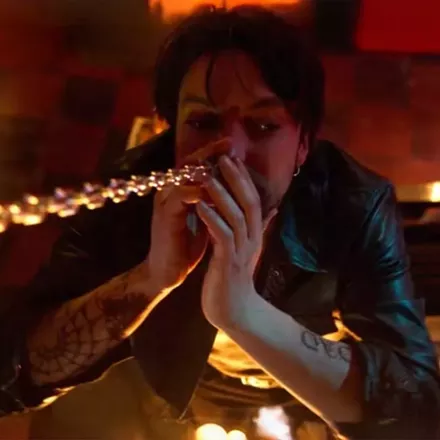Tale from the Crypt
Nightmare Alley finds Guillermo del Toro merging two distinctive storytelling traditions from the same era.
By Scott Renshaw @scottrenshawIf you gave me a list of 100 of the most critically and commercially successful directors working today, and asked me which of them was best-suited to making a contemporary film noir, I'm not sure Guillermo Del Toro would be among my first dozen choices. It's not that Del Toro doesn't have a distinctive aesthetic, or even that he might not seem comfortable in darker thematic shades; there's plenty of evidence in his career of both. It's more that his preferred stories have generally been pop entertainment, like his three different comic-book adaptations and robots-vs.-monsters adventure Pacific Rim. Even the movie that won him an Oscar is about a love story involving the Creature from the Black Lagoon. What would it even look like when Guillermo Del Toro poked his head into cynicism?
As it turns out, Del Toro has a distinctive take on film noir as evidenced by his remake adaptation of William Lindsay Gresham's novel Nightmare Alley—one that actually falls in line with an idiom he had already proved quite comfortable in. Because while this Nightmare Alley certainly traffics in some of the classic tropes of film noir, it does so with an assist from a very specific kind of comic-book sensibility.
The setting remains Depression-era America, with a drifter named Stanton Carlisle (Bradley Cooper) finding his way into the company of a traveling carnival led by veteran barker Clem (Willem Dafoe). While he works odd jobs, he begins learning the tricks of the mentalist trade from an alcoholic mentor (David Strathairn), becoming adept enough at the game to hit the road with his beloved Molly (Rooney Mara), and try to turn the showmanship of "mind-reading" into a career.
The opening hour, with its immersive focus on the world of carneys and their various acts, provides a solid foundation for del Toro's love for gleeful grotesquerie, while simultaneously feeling like a genuinely in-depth exploration of 1930s carny life. The screenplay, by del Toro and Kim Morgan, weaves in plenty of detail about how the operation runs its various rackets, while allowing Cooper's Stanton to remain a silent observer and audience proxy for long enough that it briefly feels like the character might be mute. It's such a fascinating world—populated by great character actors like Dafoe, Strathairn, Toni Collette and del Toro veteran Ron Perlman—that it's a bit disappointing to realize that we're going to have to leave it.
It's in the second hour that Nightmare Alley reveals its true noir colors, as Stanton and Molly find fame performing in the big city, then get tangled up with a mysterious psychologist (Cate Blanchett, taking to the diva mode where she's at her best). The bulk of the drama involves Stanton ignoring the advice of his veteran carny friends and getting into "spook shows" of pretending to communicate with the dead, eventually involving a wealthy mark (Richard Jenkins) who clearly should not be crossed. And it's through these attempted cons that the film shows the kind of morality tale it wants to be.
Because if it's nothing else, del Toro's Nightmare Alley is film noir as filtered through another piece of popular culture with its roots in the late-'40s and early-'50s: EC horror comics. The moments of overt gore feel perfectly in sync with the shocking tales of grim comeuppances, most familiar to more modern audiences in stuff like the Stephen King/George A. Romero collaboration Creepshow, or the Tales from the Crypt TV series. It almost seems a shame that it didn't get that kind of branding, since it might actually give the audience a better hint as to what was to come, right up to a final shot that would be at home in any vintage EC tale.
If there's one major problem with Nightmare Alley, it's that it doesn't grasp that its brand of EC-style narrative works best when it's ruthlessly lean, and this 150-minute film is not that. While there's nothing wrong with the individual pieces, the pacing feels off when they're all added together. That takes nothing away from the grin that emerges when it becomes clear what del Toro is up to, and the unique result of merging these two storytelling traditions. Tales of suckers and femme fatales do indeed work when served up with a shiver and a wink.
More by Scott Renshaw
-
Film Reviews: New Releases for May 23
Lilo & Stitch, Mission: Impossible - The Final Reckoning, Friendship, Fountain of Youth, The Last Rodeo
- May 22, 2025
-
Movie review: MISSION: IMPOSSIBLE – THE FINAL RECKONING
The series' swan song spends a bit too much time reminding us of its hero's significance.
- May 21, 2025
-
Film Reviews: New Releases for May 16
Final Destination Bloodlines, Hurry Up Tomorrow, Deaf President Now!
- May 15, 2025
- More »
Latest in Film Reviews
Readers also liked…
-
Sundance 2025 wrap-up plus February special screenings
Uncertainty about the future location shifts focus away from the movies
- Feb 5, 2025







